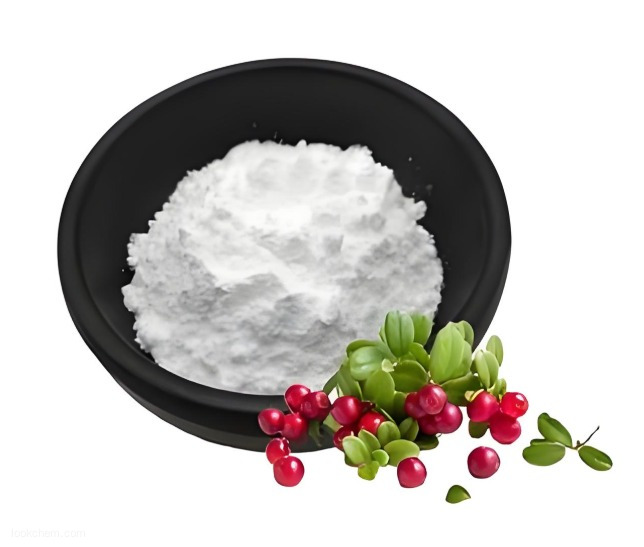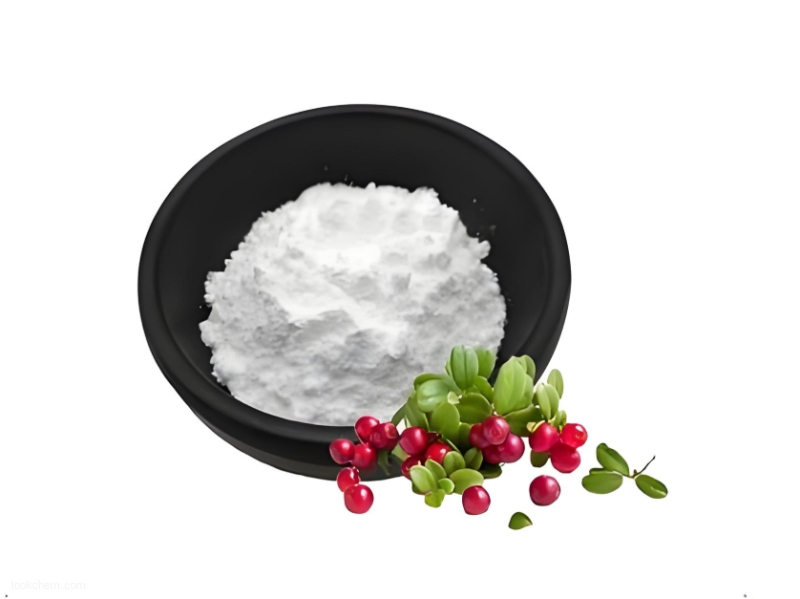|

alpha-Arbutin Basic information
|
| |
| alpha-Arbutin Chemical Properties |
| Melting point |
195-196°C |
| Boiling point |
561.6±50.0 °C(Predicted) |
| density |
1.556±0.06 g/cm3(Predicted) |
| storage temp. |
2-8°C |
| pka |
10.10±0.15(Predicted) |
| BRN |
89675 |
| InChIKey |
BJRNKVDFDLYUGJ-ZIQFBCGOSA-N |
| CAS DataBase Reference |
84380-01-8(CAS DataBase Reference) |
| |
| alpha-Arbutin Usage And Synthesis |
| Description |
Arbutin is naturally found in plant sources such as Bearberry, Cranberry and Mulberry, which essentially prevents the formation of melanin (the pigment that creates skin colour). The chemically synthesised version of this plant extract is known as Alpha Arbutin which is used as a topical skin brightening agent to treat sun spots, pigmentation and scars caused by sun damage and breakouts. It also has antioxidant properties, which protect the skin from potential sun damage. Along with Retinol, it is a fairly common ingredient in anti-ageing products to treat age spots, fine lines and wrinkles.  |
| Chemical Properties |
alpha-Arbutin is White Solid |
| Chemical Properties |
It is a glycosylated hydroquinone molecule, meaning a sugar molecule that has replaced one of the hydroxyl (-OH) groups on hydroquinone. Hydroquinone is seen as the gold standard of skin lightening, but there are concerns surrounding this well-studied tyrosinase inhibitor, such as skin sensitization, melanocytotoxicity from oxidative byproducts, and exogenous ochronosis (blue-black splotchy pigmentation) as a result of long-term application.1,2 Alpha arbutin is a more tolerable alternative to hydroquinone and is sometimes referred to as “natural hydroquinone.” Alpha arbutin functions similarly to hydroquinone, due to its molecular structure, but with reduced irritation and melanocytotoxicity. Alpha arbutin does not pose a risk in regards to exogenous ochronosis and poses minimal irritation and sensitization risk, making it a more tolerable alternative to hydroquinone. |
| Uses |
more stable analog of b-Arbutin |
| Uses |
alpha-Arbutin is a component used in the skin-whitening cosmetics. |
| Uses |
α-Arbutin may be used as an analytical reference standard for the determination of the analyte in cosmetics by high-performance liquid chromatography with UV detection (HPLC-UV) method.
|
| Definition |
Alpha arbutin, also called Hydroquinone β-D-glucopyranoside, is a naturally occurring antioxidant and skin brightener that is naturally found in the bearberry plant. It reduces melanin formation, improving the appearance of age spots, freckles, melasma, and post-inflammatory pigmentation. |
| benefits |
Ensures an even skin tone after only one month;Reduces the degree of skin tanning after UV exposure;Helps to minimize the appearance of liver spots. |
| Biological Functions |
Alpha arbutin acts as a tyrosinase competitive inhibitor and also slows melanosome maturation (the organelles that synthesize and store melanin or pigment).3 This is significant because it works on two different mechanisms of pigmentation. Melanin is derived from the amino acid tyrosine and this conversion is regulated by the enzyme tyrosinase. Alpha arbutin is similar in structure to tyrosine, which fits into tyrosinase, needed for melanogenesis. This means that alpha arbutin is reversibly competing with tyrosine for a spot on the enzyme and not inhibiting cell viability, so therefore is not cytotoxic. By targeting tyrosinase, the rate-limiting enzyme in melanin formation, as well as slowing production of the organelles that produce melanin, alpha arbutin is a potent skin brightening agent. |
| General Description |
α-Arbutin is a glycosylated hydroquinone and an anomer of naturally occurring arbutin. It is a potent inhibitor of tyrosinase, a vital enzyme involved in epidermal melanin biosynthesis. α-Arbutin finds extensive application as a powerful skin-lightening agent in cosmetic industries.
|
| Mechanism of action |
Alpha arbutin is frequently marketed as a safer alternative to hydroquinone (a popular skin-lightening ingredient that has been banned in Europe and Australia). It has similar results in brightening skin but without the dangerous bleaching process. Instead, it reduces skin’s pigment production by suppressing the enzymes that stimulate melanin. This also slows down the process by which UV light causes pigmentation, so it both prevents and treats pigmentation issues. |
| Chemical Synthesis |

In a 100 ml reaction flask, add (1.21 g, 2.5 mmol)P-acetoxyphenyl-2,3,4,6-tetra-O-acetyl-β-D-glucopyranoside 6,Add 36 ml of anhydrous methanol to dissolve, magnetically stir, add a catalytic amount of 0.06 g of sodium methoxide, react at 25 ° C for 2 hours, add acidic resin to neutralize to system pH = 7,The resin was recovered by filtration, and the filtrate was concentrated to dryness under reduced pressure.Beta-arbutinWhite solid 0.65 g,The yield was 96%. |
|


 Premiumsupplier
Premiumsupplier 



